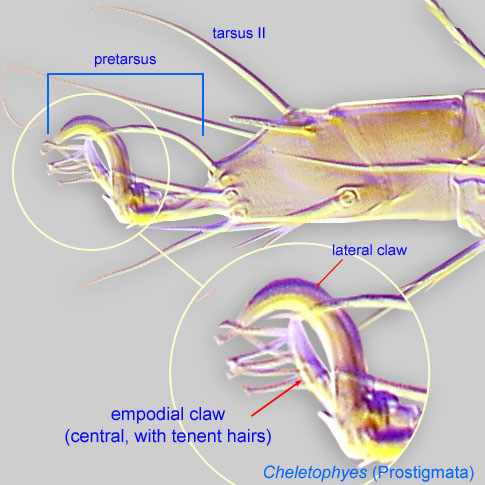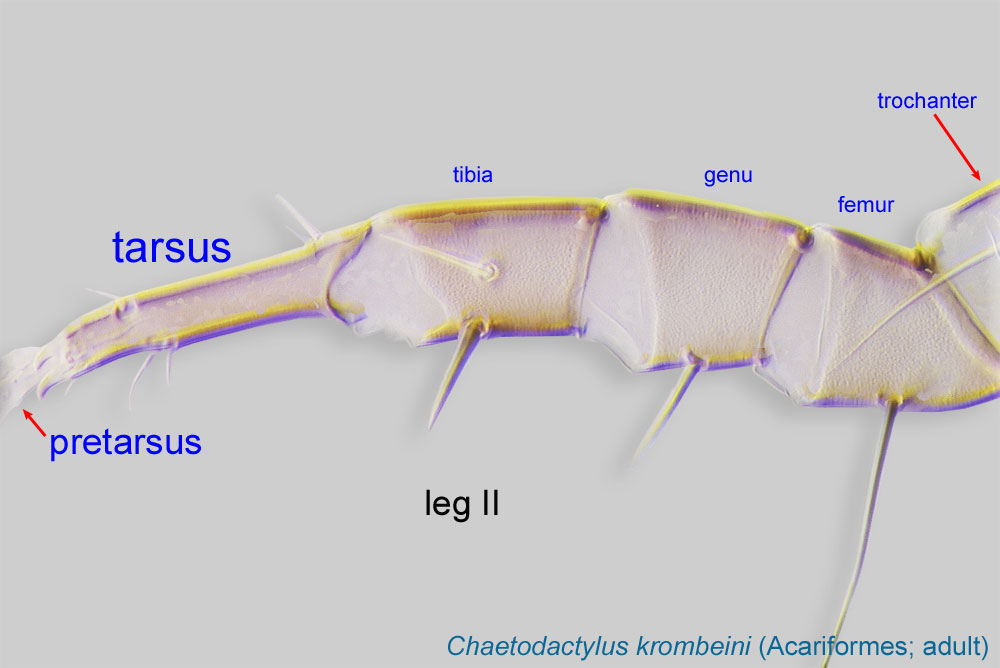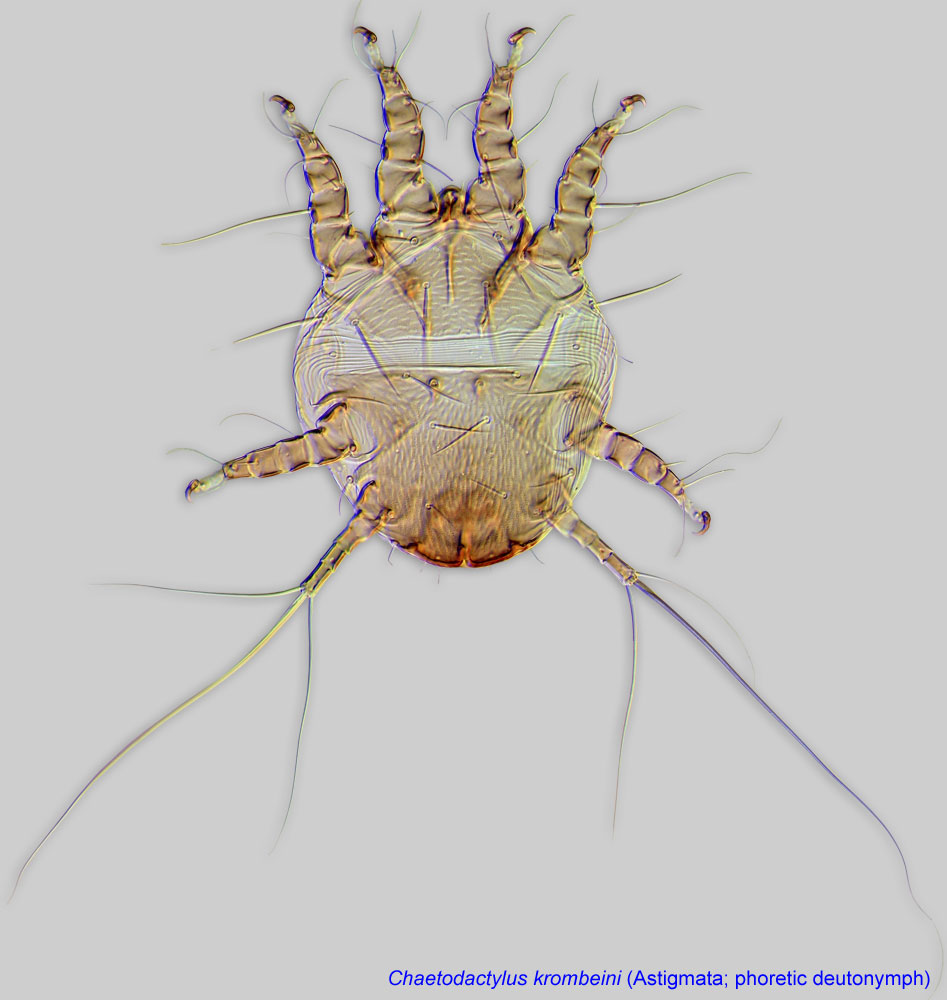lives in bee nests, but details of biology in nests unknown
Sennertionyx Zachvatkin, 1941Zachvatkin, 1941:
Zachvatkin, A. A. 1941. Tiroglifoidnue kleshchi Tyroglyphoidea [=Tyroglyphoid mites Tyroglyphoidea]. In Fauna SSSR: Paukoobraznuye, ed. S. A. Zernov, 475. Moscow-Leningrad: Akademiya Nauk SSSR (translated to English in a separate publication).
Superorder Acariformes » Order Sarcoptiformes » Suborder Oribatida » Infraorder Desmonomata » Hyporder Astigmata » Family Acaridae » Genus Sennertionyx
Trichotarsus manicati Giard 1900
wool carder bee mite
Phoretic phoretic:
Pertaining to phoresy; using another organism (i.e., a host) for dispersal to new habitats. Phoresy can be distinguished from parasitism because feeding typically does not occur during phoresy.
deutonymph: Anterior extensions of coxal apodemesapodeme:
Internal sclerite that serves as an attachment site for muscles. Most commonly used (as "coxal apodeme") to describe elements of coxae fused to the ventral body in Acariformes (coxae are free and not fused to the body in Parasitiformes), and may be variously referred to as ventral, sternal, anterior, or posterior.
 III long, almost reaching lateral sides of body (Fig. 2). Coxal setae 1a filiform, not conoidal (these setae break off easily in slide-mounted specimens, and appear as alveolar) (Fig. 2). Coxal setae 3a, 4a alveolar (not conoidal) (Fig. 1). Empodial clawsEmpodial claw:
III long, almost reaching lateral sides of body (Fig. 2). Coxal setae 1a filiform, not conoidal (these setae break off easily in slide-mounted specimens, and appear as alveolar) (Fig. 2). Coxal setae 3a, 4a alveolar (not conoidal) (Fig. 1). Empodial clawsEmpodial claw:
Claw-like, membranous, or pad-like structure of setal origin. Present only on the pretarsus in Acariformes. In Astigmata, it is the only claw on the pretarsus and often referred to simply as the claw. In the remaining Acariformes, may be accomanied by two lateral claws. Also known as empodium, pretarsal empodium, or central claw.
 I-III large, twisted, and hook-like (Fig. 2). Empodial clawempodial claw:
I-III large, twisted, and hook-like (Fig. 2). Empodial clawempodial claw:
Claw-like, membranous, or pad-like structure of setal origin. Present only on the pretarsus in Acariformes. In Astigmata, it is the only claw on the pretarsus and often referred to simply as the claw. In the remaining Acariformes, may be accomanied by two lateral claws. Also known as empodium, pretarsal empodium, or central claw.
 IV distinctly smaller than claws I-III (Fig. 2). Three long setae on tarsustarsus:
IV distinctly smaller than claws I-III (Fig. 2). Three long setae on tarsustarsus:
Terminal segment (also known as podomere or palpomere) of legs or palps. In Parasitoformes it can be subdivided into telotarsus and basitarsus.
 IV (Fig. 2). Tarsal setae aa I absent, setae ba I-II present.
IV (Fig. 2). Tarsal setae aa I absent, setae ba I-II present.
This genus includes only one described species, Sennertionyx manicati. However, undescribed species are known (our data).
By the presence of enlarged, twisted claws and coxal sclerotization, this genus is similar to Cerophagopsis. Sennertionyx differs from Cerophagopsis by its smaller claw IV as compared to claws I-III (claws I-IV are subequal in Cerophagopsis), the presence of tarsal setae aa I (absent in Cerophagopsis), and the presence of 3 long setae on tarsustarsus:
Terminal segment (also known as podomere or palpomere) of legs or palps. In Parasitoformes it can be subdivided into telotarsus and basitarsus.
 IV (1 in Cerophagopsis).
IV (1 in Cerophagopsis).
Sennertionyx manicati: France, Spain, Italy, Greece, Netherlands, and former USSR, including SE Russia. Undescribed species known from North America.
Anthidium manicatum and other species of Anthidium. Also found on Stelis punctulatissima, a kleptoparasitekleptoparasite:
An animal that takes prey or other food from another animal that has caught, collected, or otherwise prepared the food, including stored food. Both kleptoparasitic bees and kleptoparasitic mites feed on food provisioned in the host bee nest. Kleptoparasitic bees do not make their own nests; they stealthily deposit eggs in the nest of a bee host and can act as phoretic hosts for mites only because they deliver them to nests of actual bee hosts. Variant spelling: cleptoparasite.
of the principal host (Heitmans, 2013Heitmans, 2013:
Heitmans, W. R. B. 2013. Taxonomische identiteit van de wolbijenmijt Sennertionyx manicati ; nieuw voor Nederland met vermelding van de vindplaatsen (Taxonomic identity of the wool carder bee mite Sennertionyx manicati ; new to The Netherlands and notes on its distribution). Entomologische Berichten (Amsterdam) . 73 : 226-236.).
permanentpermanent:
associated exclusively with bees or their close relative, wasps; cannot live without these hosts
 disperse on bee hosts (both males and females) and their bee kleptoparasiteskleptoparasite:
disperse on bee hosts (both males and females) and their bee kleptoparasiteskleptoparasite:In the Netherlands, phoreticphoretic:
Pertaining to phoresy; using another organism (i.e., a host) for dispersal to new habitats. Phoresy can be distinguished from parasitism because feeding typically does not occur during phoresy.
deutonymphsdeutonymph:
Ontogenetic stage between protonymph and tritonymph (or adult, if tritonymph is absent). See <a href="index.cfm?pageID=1720">Life stages page</a> for more details. have been found in late May to late August on both male and female bees. The mites usually attach themselves to the propodeum and metasomal tergite I. At high densities, the mites may also attach to each other by clinging to each other using their powerful forelegs and claws. These mites can also be found in the intersegmental spaces below the posterior metasomal tergite (Heitmans, 2013Heitmans, 2013:
have been found in late May to late August on both male and female bees. The mites usually attach themselves to the propodeum and metasomal tergite I. At high densities, the mites may also attach to each other by clinging to each other using their powerful forelegs and claws. These mites can also be found in the intersegmental spaces below the posterior metasomal tergite (Heitmans, 2013Heitmans, 2013:
Heitmans, W. R. B. 2013. Taxonomische identiteit van de wolbijenmijt Sennertionyx manicati ; nieuw voor Nederland met vermelding van de vindplaatsen (Taxonomic identity of the wool carder bee mite Sennertionyx manicati ; new to The Netherlands and notes on its distribution). Entomologische Berichten (Amsterdam) . 73 : 226-236.). Biology in the nest is unknown.